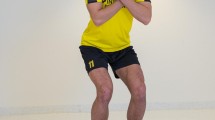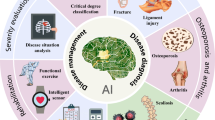Abstract
The anterior cruciate ligament (ACL) plays an important role in controlling knee joint stability. The literature provides conflicting information on whether patients with ACL deficiency exhibits gait adaptations. The aim of this study is to investigate if the use of neural networks with a new pattern recognition-based method can differentiate gait patterns between ACL deficient (ACL-D) knee and contralateral ACL-intact (ACL-I) knee in patients with unilateral ACL deficiency. The proposed method is divided into two stages. In the training stage, kinematic and kinetic gait variables are measured and compared between the two lower extremities. Gait dynamics underlying gait patterns of ACL-D and ACL-I knees are locally accurately modeled and approximated by radial basis function (RBF) neural networks via deterministic learning theory. The derived knowledge of approximated gait dynamics is preserved in constant RBF networks. In the classification stage, a bank of dynamical estimators is constructed using the preserved constant RBF networks to represent the learned training gait patterns. By comparing the set of estimators with a test gait pattern, the generated average \(L_1\) norms of errors are taken as the difference and classification measure between the training and test gait patterns. Finally, experiments are carried out on forty-three patients to assess the effectiveness of the proposed method. By using the leave-one-out cross-validation style under normal and fast walking speed conditions, the correct classification rates for discriminating between ACL-D and ACL-I knees are reported to be 95.9\(\%\) and 94.0\(\%\), respectively. Compared with other state-of-the-art methods, the results demonstrate that gait alterations in the presence of chronic ACL deficiency can be detected with superior performance and support the validity of the proposed method.






Similar content being viewed by others
References
Gao B, Cordova ML, Zheng NN (2012) Three-dimensional joint kinematics of ACL-deficient and ACL-reconstructed knees during stair ascent and descent. Hum Mov Sci 31(1):222–235
Houck JR, De Haven KE, Maloney M (2007) Influence of anticipation on movement patterns in subjects with ACL deficiency classified as noncopers. J Orthop Sports Phys Ther 37(2):56–64
Thompson-Kolesar JA, Gatewood CT, Tran AA, Silder A, Shultz R, Delp SL, Dragoo JL (2018) Age influences biomechanical changes after participation in an anterior cruciate ligament injury prevention program. Am J Sports Med 46(3):598–606
Lam MH, Fong DTP, Yung PSH, Ho EP, Chan WY, Chan KM (2009) Knee stability assessment on anterior cruciate ligament injury: clinical and biomechanical approaches. Sports Med Arthrosc Rehabilit Ther Technol 1(1):1
Takeda K, Hasegawa T, Kiriyama Y, Matsumoto H, Otani T, Toyama Y, Nagura T (2014) Kinematic motion of the anterior cruciate ligament deficient knee during functionally high and low demanding tasks. J Biomech 47(10):2526–2530
Ismail SA, Button K, Simic M, Van Deursen R, Pappas E (2016) Three-dimensional kinematic and kinetic gait deviations in individuals with chronic anterior cruciate ligament deficient knee: a systematic review and meta-analysis. Clin Biomech 35:68–80
Berchuck M, Andriacchi TP, Bach BR, Reider B (1990) Gait adaptations by patients who have a deficient anterior cruciate ligament. J Bone Jt Surg 72(6):871–877
Eitzen I, Eitzen TJ, Holm I, Snyder-Mackler L, Risberg MA (2010) Anterior cruciate ligament deficient potential copers and noncopers reveal different isokinetic quadriceps strength profiles in the early stage after injury. Am J Sports Med 38(3):586–593
Muneta T, Seklya I, Ogiuchi T, Yagishita K, Yamamoto H, Shinomiya K (1998) Objective factors affecting overall subjective evaluation of recovery after anterior cruciate ligament reconstruction. Scand J Med Sci Sports 8(5):283–289
Stajduhar I, Mamula M, Miletic D, Unal G (2017) Semi-automated detection of anterior cruciate ligament injury from MRI. Comput Methods Progr Biomed 140:151–164
Zabala ME, Favre J, Scanlan SF, Donahue J, Andriacchi TP (2013) Three-dimensional knee moments of ACL reconstructed and control subjects during gait, stair ascent, and stair descent. J Biomech 46(3):515–520
Chen HC, Wu CH, Wang CK, Lin CJ, Sun YN (2014) A Joint-constraint model-based system for reconstructing total knee motion. IEEE Trans Biomed Eng 61(1):171–181
Andriacchi TP, Dyrby CO (2005) Interactions between kinematics and loading during walking for the normal and ACL deficient knee. J Biomech 38:293–298
Moraiti C, Stergiou N, Ristanis S, Georgoulis AD (2007) ACL deficiency affects stride-to-stride variability as measured using nonlinear methodology. Knee Surg Sports Traumatol Arthrosc 15:1406–1413
Lindstrom M, Fellander-Tsai L, Wredmark T, Henriksson M (2010) Adaptations of gait and muscle activation in chronic ACL deficiency. Knee Surg Sports Traumatol Arthrosc 18(1):106–114
Andriacchi TP, Briant PL, Bevill SL, Koo S (2006) Rotational changes at the knee after ACL injury cause cartilage thinning. Clin Orthop Relat Res 442:39–44
Christian J, Kroll J, Strutzenberger G, Alexander N, Ofner M, Schwameder H (2016) Computer aided analysis of gait patterns in patients with acute anterior cruciate ligament injury. Clin Biomech 33:55–60
Eskofier BM, Kraus M, Worobets JT, Stefanyshyn DJ, Nigg BM (2012) Pattern classification of kinematic and kinetic running data to distinguish gender, shod/barefoot and injury groups with feature ranking. Comput Methods Biomech Biomed Eng 15(5):467–474
Altilio R, Paoloni M (2017) Selection of clinical features for pattern recognition applied to gait analysis. Med Biol Eng Comput 55(4):685–695
Chau T (2001) A review of analytical techniques for gait data. Part 2: neural network and wavelet methods. Gait Posture 13(2):102–120
El Habachi A, Moissenet F, Duprey S, Cheze L, Dumas R (2015) Global sensitivity analysis of the joint kinematics during gait to the parameters of a lower limb multi-body model. Med Biol Eng Comput 53(7):655–667
Federolf P, Tecante K, Nigg B (2012) A holistic approach to study the temporal variability in gait. J Biomech 45(7):1127–1132
Cabitza F, Locoro A, Banfi G (2018) Machine learning in orthopedics: a literature review. Front Bioeng Biotechnol 6:75
Matic A, Savic SP, Ristic B, Stevanovic VB, Devedzic G (2016) Infrared assessment of knee instability in ACL deficient patients. Int Orthop 40(2):385–391
Pandey G, Dukkipati A (2017) Unsupervised feature learning with discriminative encoder. In: 2017 IEEE international conference on data mining, pp 367–376.3
Zhang J, Yu J, Tao D (2018) Local deep-feature alignment for unsupervised dimension reduction. IEEE Trans Image Process 27(5):2420–2432
Ning G, Zhang Z, He Z (2018) Knowledge-guided deep fractal neural networks for human pose estimation. IEEE Trans Multimed 20(5):1246–1259
Rhodin H, Salzmann M, Fua P (2018) Unsupervised geometry-aware representation for 3D human pose estimation. In: European conference on computer vision
Yu J, Rui Y, Tao D (2014) Click prediction for web image reranking using multimodal sparse coding. IEEE Trans Image Process 23(5):2019–2032
Yu J, Tao D, Wang M, Rui Y (2015) Learning to rank using user clicks and visual features for image retrieval. IEEE Trans Cybern 45(4):767–779
Hong C, Yu J, Wan J, Tao D, Wang M (2015) Multimodal deep autoencoder for human pose recovery. IEEE Trans Image Process 24(12):5659–5670
Hong C, Yu J, Tao D, Wang M (2015) Image-based three-dimensional human pose recovery by multiview locality-sensitive sparse retrieval. IEEE Trans Ind Electron 62(6):3742–3751
Yu J, Yang X, Gao F, Tao D (2017) Deep multimodal distance metric learning using click constraints for image ranking. IEEE Trans Cybern 47(12):4014–4024
Mehdizadeh S (2017) The largest Lyapunov exponent of gait in young and elderly individuals: a systematic review. Gait Posture 60:241–250
Jac Fredo AR, Josena TR, Palaniappan R, Mythili A (2017) Classification of normal and knee joint disorder vibroarthrographic signals using multifractals and support vector machine. Biomed Eng Appl Basis Commun 29(03):1750016
Zhang Y, Ji X, Liu B, Huang D, Xie F, Zhang Y (2017) Combined feature extraction method for classification of EEG signals. Neural Comput Appl 28(11):3153–3161
Yentes JM, Hunt N, Schmid KK, Kaipust JP, McGrath D, Stergiou N (2013) The appropriate use of approximate entropy and sample entropy with short data sets. Ann Biomed Eng 41(2):349–365
Kaipust JP, Huisinga JM, Filipi M, Stergiou N (2012) Gait variability measures reveal differences between multiple sclerosis patients and healthy controls. Mot Control 16(2):229–244
Wang C, Hill DJ (2006) Learning from neural control. IEEE Trans Neural Netw 17(1):130–146
Wang C, Hill DJ (2007) Deterministic learning and rapid dynamical pattern recognition. IEEE Trans Neural Netw 18(3):617–630
Wang C, Hill DJ (2009) Deterministic learning theory for identification, recognition and control. CRC Press, Boca Raton
Wang C, Chen T, Chen G, Hill DJ (2009) Deterministic learning of nonlinear dynamical systems. Int J Bifurc Chaos 19(4):1307–1328
Farrell J (1998) Stability and approximator convergence in nonparametric nonlinear adaptive control. IEEE Trans Neural Netw 9(5):1008–1020
Azar AT, El-Said SA (2014) Performance analysis of support vector machines classifiers in breast cancer mammography recognition. Neural Comput Appl 24:1163–1177
Chu K (1999) An introduction to sensitivity, specificity, predictive values and likelihood ratios. Emerg Med Australas 11(3):175–181
Yuan Q, Cai C, Xiao H, Liu X, Wen Y (2007) Diagnosis of breast tumours and evaluation of prognostic risk by using machine learning approaches. In: Huang DS, Heutte L, Loog M (eds) Advanced intelligent computing theories and applications. With aspects of contemporary intelligent computing techniques. Springer, Berlin, pp 1250–1260
Kaplan Y (2015) Identifying individuals with an anterior cruciate ligament deficient knee as copers and non-copers: a narrative literature review. J Sci Med Sport 19:e26
Iliopoulos E, Galanis N, Iosifidis M, Zafeiridis A, Papadopoulos P, Potoupnis M, Kirkos J (2017) Anterior cruciate ligament deficiency reduces walking economy in copers and non-copers. Knee Surg Sports Traumatol Arthrosc 25(5):1403–1411
Robinson MA, Donnelly CJ, Tsao J (2014) Impact of knee modeling approach on indicators and classification of anterior cruciate ligament injury risk. Med Sci Sports Exercise 46(7):1269–1276
Atarod M, Frank CB, Shrive NG (2014) Kinematic and kinetic interactions during normal and ACL-deficient gait: a longitudinal in vivo study. Ann Biomed Eng 42(3):566–578
Huang H, Guo J, Yang J, Jiang Y, Yu Y, Müller S, Ao Y (2017) Isokinetic angle-specific moments and ratios characterizing hamstring and quadriceps strength in anterior cruciate ligament deficient knees. Sci Rep 7(1):7269
Almosnino S, Brandon SC, Day AG, Stevenson JM, Dvir Z, Bardana DD (2014) Principal component modeling of isokinetic moment curves for discriminating between the injured and healthy knees of unilateral ACL deficient patients. J Electromyogr Kinesiol 24(1):134–143
Berruto M, Uboldi F, Gala L, Marelli B, Albisetti W (2013) Is triaxial accelerometer reliable in the evaluation and grading of knee pivot shift phenomenon? Knee Surg Sports Traumatol Arthrosc 21(4):981–985
Kopf S, Kauert R, Halfpaap J, Jung T, Becker R (2012) A new quantitative method for pivot shift grading. Knee Surg Sports Traumatol Arthrosc 20(4):718–723
Xu G, Wang Z, Huang H, Li W, Liu C, Liu S (2018) A model for medical diagnosis based on plantar pressure. arXiv preprint arXiv:1802.10316
Hua J, Xiong Z, Lowey J, Suh E, Dougherty ER (2004) Optimal number of features as a function of sample size for various classification rules. Bioinformatics 21(8):1509–1515
Kamruzzaman J, Begg RK (2006) Support vector machines and other pattern recognition approaches to the diagnosis of cerebral palsy gait. IEEE Trans Biomed Eng 53(12):2479–2490
Acknowledgements
This work was supported by the National Natural Science Foundation of China (Grant Nos. 61773194, 61304084), by the Natural Science Foundation of Fujian Province (Grant No. 2018J01542) and by the Program for New Century Excellent Talents in Fujian Province University.
Author information
Authors and Affiliations
Corresponding author
Ethics declarations
Conflict of interest
There is no conflict of interest.
Additional information
Publisher's Note
Springer Nature remains neutral with regard to jurisdictional claims in published maps and institutional affiliations.
Rights and permissions
About this article
Cite this article
Zeng, W., Ismail, S.A., Lim, Y.P. et al. Classification of Gait Patterns Using Kinematic and Kinetic Features, Gait Dynamics and Neural Networks in Patients with Unilateral Anterior Cruciate Ligament Deficiency. Neural Process Lett 50, 887–909 (2019). https://doi.org/10.1007/s11063-018-9965-7
Published:
Issue Date:
DOI: https://doi.org/10.1007/s11063-018-9965-7




